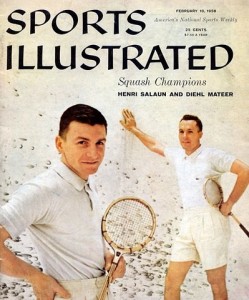
Northampton, MA — G. Diehl Mateer Jr., a member of the Men’s College Squash Association Hall of Fame, passed away on September 22, 2012. He was 84. Rob Dinerman of the DailySquashReport.com first reported Mateer’s passing.
Representing Haverford College, Mateer won the intercollegiate singles championship in 1948 and 1949. In 1990, along with Germain Glidden (Harvard University), Charles Ufford (Harvard University), Charles M. P. Brinton (Princeton University), and Beekman Pool (Harvard University), Mateer was a member of the inaugural class of the Men’s College Squash Association Hall of Fame.
During his singles career, his chief rival was Henri Salaun, a Wesleyan graduate. The two players were featured on the cover of the February 10, 1958 edition of Sports Illustrated. The two players first battled in the 1949 Intercollegiate semifinals, which Mateer won with ease. According to the Haverford Athletics website, “Mateer proved to be an almost unparalleled competitor with a racquet in his hands and remains the only Scarlet and Black athlete to ever appear on the cover of Sports Illustrated.”
According to Dinerman:
[Mateer was a] three-time U. S. National champion, two-time Intercollegiate champion, record 11-time U. S. National Doubles champion, and the only amateur to win the North American Open twice, Mateer was one of the truly great squash players for more than two decades (from the early-1950’s until well into the 1970’s) and literally a first-ballot USSRA Hall Of Famer, having been one the 15 all-time greats who comprised the first class of inductees in 2000. He has also been elected, in each case as well as part of the inaugural group of honorees, into the U. S. Intercollegiate, Haverford College, Maryland State Association and Episcopal Academy Halls Of Fame, and his great and extended series of final-round matches against his contemporary Henri Salaun, especially during the last half of the decade of the 1950’s, made for one of the most memorable and resplendent rivalries in the history of the sport.
In his Winning Squash Racquets, Jack Barnaby, the legendary Harvard squash coach, wrote:
Mateer had everything: strength, stamina, power, touch, size, mobility, and toughness. Above all, he was a power player… No one ever looked more impressive in the court or applied more continuous pressure throughout a match. Forehand and backhand and volley — all were very severe and well executed. He also had early training. He won the Intercollegiates in his sophomore year, figuratively, without taking off his sweater.
In Squash: A History of the Game, James Zug writes of Mateer:
In 1950 Mateer was unable to collect his third intercollegiate championship as a senior because it was scheduled in Amherst the same weekend as the national doubles in St. Louis. A sign of Mateer’s precociousness, it was the first time a player had such a conflict. Mateer’s decision to play in the national doubles indicated that he was tired of sleepwalking to victory in college matches.
Mateer is predeceased by Joan, his wife of 41 years, who passed away in 1993. Ann Eldridge, Mateer’s second wife, cared for him until his death.



